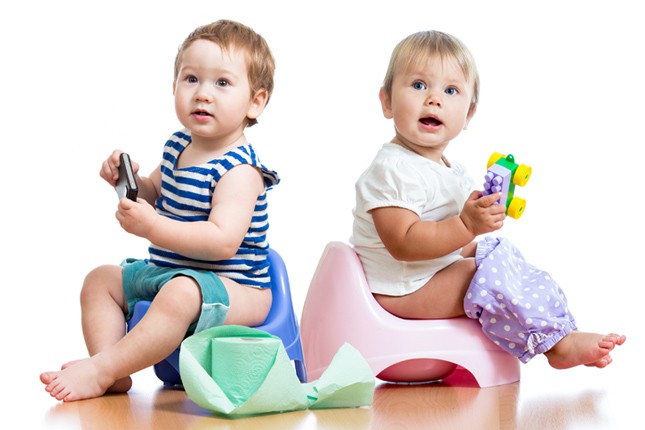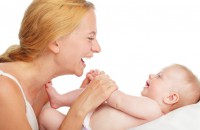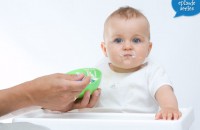Twin Talks
Potty Training Twins: Gear and Logistics
[00:00:00]
Please be advised, this transcription was performed from a company independent of New Mommy Media, LLC. As such, translation was required which may alter the accuracy of the transcription.
[Theme Music]
CHRISTINE STEWART-FITZGERALD: Potty training is a big step for both kids and their parents and being prepared for the right tools and knowing how to use them can be a big help especially when potty training two kids at once. What are the potty training essentials and what seems to work best for the parents? We turn for parent panelist to learn more about their personal experience. This is Twin Talks.
[Theme Music/Intro]
CHRISTINE STEWART-FITZGERALD: Welcome to Twin Talks, broadcasting from the Birth Education Center of San Diego. Twin Talks is your online, on the go, support group, from expecting and new parents of twins, and I'm your host, Christine Stewart Fitzgerald. Now we know twin parents are very busy, so you can download the Twin Talks app, available on the Android, iTunes and Windows Marketplace. If you want to have our episodes delivered straight to you, then subscribe to our podcast through iTunes and each episode will automatically download to your mobile device. I'm going to turn this over to Sunny, who's going to talk about our virtual panelist program.
SUNNY GAULT: Thank you Christine. So, yes, for everyone who's not here in our studio, here in San Diego, there's a great way to participate in our shows, it's through our virtual panelist program. So what I'm going to be doing throughout the show, and what I do before we record the shows, and even after, is I go on social media, so our Facebook page, our Twitter page, I am posting questions that a lot of you guys have had, that you guys has sent us regarding the episodes and the topics we're talking about. If you guys want to ask questions to our experts, I mean you're more than welcome to do so. We want to continue this conversation online as much as possible, so like us on Facebook, you can follow us on Twitter, we're using the hashtag 'twintalksvp', the 'vp' stands for virtual panelist. And I'm going to hop on right now, take some pictures and start the conversation.
CHRISTINE STEWART-FITZGERALD: Alright, well let's jump into this and let's get started and introduce ourselves. I will introduce myself, I'm your host, and I've got identical girls who are now 5 and a half years old, in kindergarten, so our potty training experience was not that long ago. And then I do have a singleton girl, who is 2 and a half and we've been doing this potty training thing for the last year now, so this is near and dear to my heart.
SUNNY GAULT: So you're making progress with it then?
CHRISTINE STEWART-FITZGERALD: I don't know, I really don't know. That's a good question, yeah. Let's see, we got Brandy on the phone:
BRANDI WALLACE: Hello, I am Brandy Wallace, I am the happy proud mother of 2 sets of twins: I have identical boys that are 5 and a half, same age as Christine's girls, but mine are not yet in kindergarten. And I also have fraternal boy girl twins that are 2 and a half, like Christine's singleton, and we have not even started down the potty training route the second time around, so we are coming upon that intersection right now.
CHRISTINE STEWART-FITZGERALD: Yes, and considering that you have more boys than girls, and I think we'll talk more about that, I mean the difference. And Sunny, over to you.
SUNNY GAULT: Alright, so I have 4 children myself, my oldest is about to go into kindergarten in September, a boy, so he will be 5 in July, and my middle guy is just turned 3, and I have identical twin girls who are about 18 months and so, 18 months seems a little early to start potty training, they are girls, so I don't know, maybe they have a little edge up because they're girls, I've heard that a lot, but my experience is been with boys, not having the edge up per say. And so, we have not going down that path, I'm actually in the process of potty training my 3 years old, so I've got potty training experience, not so much with twins, but yeah, I'll definitely be taking notes during this session.
[Theme Music]
SUNNY GAULT: Alright. Okay, so before we start today's show we are going to talk about a news headline, and we like to find headlines that are online, kind of making the rounds, obviously specifically how do we do with twins, and multiples, and this one I thought was really inspirational, really talks about the bond between twins, and how they can really help one another out.
This headline says '3-month-old Tod cried to save her twin brother's life after he stopped breathing in his sleep'. So the twins we're basically sleeping together, boy girl twins, and I should say that they we're way premature. When they we're born, they we're born at 25 weeks, and very, very tiny, not even 2 pounds. This happened when they we're 3 months old, and the little girl, her name is Amy, her twin brother Jake just stopped breathing and, call it intuition, she kind of knew something was wrong, and she started crying, and fortunately, the parents heard it right away, and the husband Chris, was actually trained to resuscitate a baby. It doesn't really say why, maybe he was a medic of some sort, or maybe he just had some CPR training. Husband woke up, went in, and he said the baby's lips we're blue, like everything we just totally cringe on when we think of SID’s, and all the things that can happen. But it was because his sister cried that the dad woke up, came in and they took the baby to the hospital, and the baby ended up surviving, and is okay, and I'm sure that parents are still on edge, I'm sure they have monitors galore in their house, you know trying to prevent accidents like this from happening, but I thought it was again, just a really nice story to, you know, showcase, you know, how twins kind of take care of one another, in ways that we don't always necessarily see.
CHRISTINE STEWART-FITZGERALD: Oh yeah, you know, I think this is an amazing story, and to me, I mean that just illustrates like how close, and in tune I mean twins are. Think about it, you hear all these studies about how twins are aware of each other in the womb and I mean I truly believe that, I mean, they know, I mean they're communicating on a you know, non-verbal level, and there's this sense of well being. Soon as we talk about pets have that sense of well being, then you can imagine that for humans, I mean so much more intense, so I'm sure that at some level, you know, here she is a 3 month old, well you know, age adjust probably, you know a 9 month old baby and she just somehow knew that, you know, and that's just instinctive, I'm mind boggled.
SUNNY GAULT: It turns out that her little brother Jake, medics found that his lung had collapsed and he was also fighting 3 infections. Oh my gosh. And Brandy, I'm sure you see, you know with your twins, just kind of how they support each other, and you know, just help each other out.
BRANDY WALLACE: Oh absolutely, the younger set right now are still on their crib, and if, you know, one is upset, the other calls for me, and calls me out or my sister or my brother's name 'Mommy, so and so needs you". So you know, he especially takes care of her, unless we know what she needs, and the other days she started to cry, because she was upset, and he looked at her, and he stars crying too, like he felt her pain. And wanted to cry along with her.
SUNNY GAULT: And then you wanted to cry, because they we're crying.
[Theme Music]
CHRISTINE STEWART-FITZGERALD: Potty training is an important milestone in your twin's life. And considering how many diapers twin parents go through on any given day, it's easy to see why. Today we're learning about the gear and logistics used by many twin parents as they begin this daunting challenge. So, of course, probably the biggest thing we all start off with, is some form of a potty chair. You know, we're talking about those little, either the tiny little bowl, you know, almost they're like large cups I would say, or to the more elaborate, you know, little seats that, I know I've got some, that play music when the kids pee. So, you know, I got them as second hand through people in our twin's club, which is great, since you're not really using them for such a long period, and I know that in my case, we found that having them was a really big help, because it just brought everything down to their level. So when we're in the process of teaching them to pull their own pants and try to be independent, it was one last thing to worry about okay, they have to climb up and do things that are maybe size wise, this was right there on their level.
BRANDY WALLACE: Actually with my first son we went with the minimalist approach, we had enough gear and I thought I'm going to try to make this as realistic as possible, because they we're not going to have little baby potty chairs, so we just went straight to the big person toilet, and we had one of the seat adapters that folds out the lid that they can pull down, and I think we went to the Home Depot and bought it for 30$ or something, so we had a whole new toilet seat. And it has a little child seat that fold out the lid and they could use that, and we didn't had any extra gear. The second time around, I feel that we're going to go with the opposite route, because just logistically I now have 4 children needing to use one toilet. So just number wise, I'm going to need extra kid potties standalone sitting around the bathroom.
CHRISTINE STEWART-FITZGERALD: So you're talking about seats. You need to have places for the little bums to put themselves. That is a consideration, definitely. You know I have to say, that with the potty training is an advantage because, generally, I don't know, I haven't seen any bathrooms in people's homes where they have more than one toilet, or maybe for twins, that is you.
BRANDI WALLACE: Well I mean you say that in generally, but I'm friends with triplets’ mom who just remodeled a home they are living in, and her husband was really pushing for a urinal, and they have triple boys. And they opted against it, and their mom says "I really kind of regret that decision".
SUNNY GAULT: Well that's really interesting. I could see that totally. So it's a urinal, the idea at least was a urinal, then a potty. So not 2 potties, or toilets. So here is my take on this. So, again, I have a 5 year old that I've almost potty trained, and I have a 3 year old that is going through the process. So I haven't entered the twin area yet, but I will say that up to this point we had used what Brandy basically describes. So, online they call it a seat reducer, or like a potty seat, and we did the same thing, we went to like Home Depot or something like that, and it's something that actually fits on the seat, I guess you can get a couple of different styles. So our actually screws into the seat or something like that, so it's like you lift up the toilet lid, right? So you've got that layer, and then there's a little baby thing that you can lift up. So it's kind of like multiple layers. So you know, any adult could use it, and be fine too, they just have to lift up that little baby seat and it would go behind them just like a toilet lid would go behind you if you're sitting on the toilet.
CHRISTINE STEWART-FITZGERALD: And I think now when you are talking about, it is built in so you can actually close the toilet lid completely?
SUNNY GAULT: Yes, and that worked really, really well for us, at least for the 2 boys, right? But I didn't have babies that needed to go potty at the same time, but it has worked really well, specially now when my 5 years old goes to the bathroom, my 3 year old must almost always go with him, it's kind of like show and tell, I don't know. He wants to get to see what's going on. And I never had that issue of, you know, 2 boys wanting to go at the exact same time. I can feel that coming on with my girls though, because whenever one does something, the other one wants to do it, and so, I think I'm just going to , just like Brandy, adjust my way of thinking here. But my concern with just the potty chair, so if I wouldn't do the seat reducer thing, you know, I just went with potty chairs, I just feel that's so much more to pick up and maybe it's no worse than diapers honestly, I just feel like I'm touching stuff that I don't want to touch all day long already.
CHRISTINE STEWART-FITZGERALD: Yeah I know, the dumping and disposing, I hear you, definitely. Now I will say in my case, with the girls, you know my girls are just very social creatures, so when we had that little potty seats, they would sit there and they would, I mean like for a while we had it kind of in our kitchen area over, I should not say kitchen, but the eating area so it was just convenient for them as a public space, and they could just go sit down and they would sit there like together and they read books, and they talk, and it was like you know, fast forward-thinking of going to the bathroom together, it all starts here, and they we're entertaining each other. And I think, you know, I see with my singleton she does sit on the potty seat, but I have to go entertain her, so I think there might be an advantage having the two being able to sit there.
SUNNY GAULT: In public, you know, I mean in an area that most people just kind of sit and chat. So not necessarily in a bathroom?
CHRISTINE STEWART-FITZGERALD: Right, exactly, so you can have them in an area where you can see them, you can supervise them, and because I found that sometimes, at least in my case, I am sitting with my singleton, and it can be 20 minutes, it can be 40 minutes.
SUNNY GAULT: Oh my goodness. You're like on your phone, on Facebook, Twitter.
CHRISTINE STEWART-FITZGERALD: Yes. Yes. So I mean, I would say if you do like to get the potty chairs, definitely get 2 of them. So they are not fighting over it. If you are going to use the big potty, the first you need step stools, so what did you guys used for stools?
SUNNY GAULT: So this was kind of interesting in our house: I started with one step stool, but I think not only did we need it for the seat reducer thing, you know that we had, but we also needed it for them to be able to reach the sink, you know, to wash their hands and stuff like that. So I think regardless of what potty you go to, you'll probably need a step stool. We just went to Ikea, and I had some really cheap stools, we used plastic simply because is easy to wash and especially when you're talking about little boys trying to learn to go potty there's a lot of spilling and missing the toilet and it's just, the thought of not having plastic to easily wipe stuff off it just grosses me out, so that's what we use, it just has some grip stuff at the top it's super, I think we paid less than 5 bucks for it.
CHRISTINE STEWART-FITZGERALD: And how about you, I mean Brandy, of course with boys as well?
BRANDI WALLACE: I never consider the floor to be just wood, for anything really. We also had the plastic, but we had different versions, different size, one had a little handle, so they can move it from here to there, and then we just wanted something cheap and easy because that's all we really needed.
CHRISTINE STEWART-FITZGERALD: I don’t know if we over did it but we have got like step stools galore in our house . . .
SUNNY GAULT: You do, you do. You get tons of it, and I like the idea of having something available in each bathroom, if you have the space, because those stools, you know, even if they collapse you have to worry about uncollapsing on a child, you know what I mean, there's always something.
BRANDI WALLACE: Always the danger of pinching a finger.
SUNNY GAULT: Yes, oh my gosh. Even for mummies out there. Been there done that.
CHRISTINE STEWART-FITZGERALD: Let's talk toilet paper. When you switch over from diapers to the potty, do you generally using wipes which help get their little bums clean and then eventually you can then get over them using toilet paper on their own, but that does take a while, so how is then for you, I mean did you do a hard cut over, or did you continue using wipes in sort of helping them learn how to clean themselves?
BRANDI WALLACE: We had sort of 2 different purposes: first of all number one is when they're using the big potty and they get to be in that magical place called the bathroom, and that they are pretty limited on exposure to and until too that point. They were thrilled with the toilet paper. They wanted to use toilet paper because it was new, and it was round, and it rolls, and all that stuff, so we actually had a toilet paper for wet and dirty they can use the flushable wipes. Because they have had a familiar feeling for them because they have already been exposed to diaper wipe. So we actually put a limit, because I know everybody has this problem with how much toilet paper is too much toilet paper. We limited them to the number of squares to the number of years they were old, like my first step was 3, 3 squares on a small bottom is plenty, and they had fun counting it out, and if they needed more than that, we went to the flushable wipes. Another tip too with the toilet paper, instead of with the number of squares, depending on where your toilet paper roll is mounted or you know how high it is off the ground, we also allowed them . . . their grandmother’s house and we will roll the toilet paper until it touches the floor, because it wasn’t that long of a distance, but it was something fun for them to unroll – roll and then stop.
SUNNY GAULT: I like that too. You know, I actually got rid of toilet paper in at least their own bathroom I still don't trust any of them with toilet paper. We do have the flushable wipes that we keep right next to the toilet, and what I found for whatever reason is that they respect that more than toilet paper. Toilet paper is just fun to just play with, and run with all around the house, but when you try like wet wipes, I don't know, for some reason it's not as fun to mess around with, and so I honestly, this may be a little TMI, but I still have to take care of my almost 5-year-old in that department of wiping and stuff like that, you know but the wipes really help and like I said, I don’t think he feels as clean as using the regular toilet paper, so the wipes are a must in our house. But don't use the ones just for the regular diapers stuff, if you use disposable wipes for that because than can clog your toilet. So there are specific wipes out there that for some reason are flushable, and fine, so just look for that on the packaging.
BRANDI WALLACE: Save your plumbing.
CHRISTINE STEWART-FITZGERALD: Yes. Hand soap – Which you know, I know it's not a big deal, but you know, sometimes it can add to the fun experience of kids in their bathroom experience: anybody used anything that was kind of fun, or filming or scented?
BRANDI WALLACE: We didn't actually used any of these, my boys had a problem, even the younger kid now, have a problem when he used too much soap, so my way around that was just finding scent that was really bad for them so they could really get enough, but not too much, you know.
CHRISTINE STEWART-FITZGERALD: We will take a break, and when we will come back we're going to learn more about the gear that can help you prepare your twins for their potty training experience. We'll be right back.
[Theme Music]
CHRISTINE STEWART-FITZGERALD: Well welcome back, today we're talking with our twin parents about what potty training gear worked bet for them when potty training their twins. We talked about some items that you might need in the bathroom, so let's talk about some items specifically for your twins. Okay, so, how about, for the big kid underwear, was that an incentive for your twins? I know I told my girls that we want to look, you know big kids wear panties, and you could go, I know we said 5 days without having any kind of accident, then you get to get some Dora panties. That was the big reward, you know.
SUNNY GAULT: I can say it worked with my boys. My boys just love, you know because we have the superheroes, then Thomas the train and Elmo, and all of that, and you know, my 3-year-old today would be like "I want to wear Elmo underwear", you know, and he wakes me up, first thing in the morning, he wears the training pants at night, so we're not ready, I am so not ready to take that leap yet over night, or naps.
But first thing in the morning, he wants the training pants off, and he wants his Elmo underwear on, and it doesn't matter if it's 7 in the morning, 6:30 in the morning, this was this morning, but yeah, huge incentive in my house.
CHRISTINE STEWART-FITZGERALD: How about you, Brandy?
BRANDY WALLACE: We have the same scenario: finding that character that they love so much, actually in the potty training process we would let them wear the panties over the diaper, you know for a little bit, and then once they understood that you can actually wear these without a diaper, that was an even bigger incentive. So then so yes, I know the exact thing you're talking about.
SUNNY GAULT: Oh my gosh Brandy, it's so funny you said that because, so my boys go to preschool, and a couple of times my 3 year olds come home with training pants underneath, and underwear on top, and I was so perplexed by this. I'm like did they forget to take the diaper off? What is going on, and that totally makes sense now that you said that. I had no idea what was the way to train them.
BRANDY WALLACE: Then you mentioned training pants, I want to say what are different phases of underwear for a while, because we never used the plastic line, because we wanted them to feel the wetness, and make them uncomfortable and you know, motivate the body, if that would still happen. But first, we went on a different route, but we we're prepared for that. But then we ended up getting the, I don't know if they are called training pants, but they had a sticker in front to them so they just didn’t quite get there in time. It wouldn’t completely sock themselves, it wasn’t like they wet themselves. But it had a little thicker front to them, before we graduated to the really thick cotton ones.
CHRISTINE STEWART-FITZGERALD: Did you also use pull-ups, I mean in kind of in progressive, I mean if you go from like let's say you used disposable diapers to the training, did you used pull-ups, before you got to the training pants?
BRANDI WALLACE: - I know that we used pull-ups for nap and bed, for the sleeping time, but we didn't used pull-ups during the waking hours, and we never used those during the regular day, just nap and bed and before using them at night, for a long time.
CHRISTINE STEWART-FITZGERALD: Kind of the same thing, I mean we did, we we're using cloth diapers and they could take them off themselves but couldn't quite put them back on, so we thought okay, we need to move to training pants, so we tried the thick cloth plain old training pants. And it was pretty much when they got to the point where they could go for several hours without wetness. And then yeah, we used pull-ups disposables at night time. How about, you know for rewards, and incentives, did you used any kind of charts or I don't know, stickers, jellybeans, how did you, what was your motivating factor?
BRANDI WALLACE: Well for us, it's the motivating factor and my advice for any parent is find their currency. What does it for your kid? Because mine never responded to sticker charts, or prizes or things like that. My children were motivated by candy. The day that we were training we actually used M&M for them, and we actually checked to see if they we're clean and dry, like every 20 minutes, we didn't reward them for going to the potty. We were rewarding them for checking if they were clean and dry and then they got a little M&M. If they went to the potty they got an extra one. So they could make a connection between feeling the pressure and getting to the potty. So once we kept checking for clean and dry, which is actually the end result, then they understood it. But I very quickly realized that you know we start at 8 AM and by noon we were done. But I also realized by noon I wasn't parenting my children anymore, I was parenting the chocolate. So the very next day we switched to I think gummy bears. A lot was stuffed for them and it was pointed put to me later and I adapted this may be like on day two or three to fill up a clear jar with their treats in it, a clear jar for each of them, for each of their own and when the jar is empty you are potty trained and you know what needs to do and you don’t get the treats anymore.
SUNNY GAULY: Well that is smart because yes that is always the question as when do you end, you know what I mean, because they just start to expect it.
BRANDI WALLACE: Yes, they knew what to expect, because they kept watching the jar get smaller and smaller but they knew.
SUNNY GAULY: Well that is a good idea. Brandy have you heard of putting M&M especially for boys in the toilet as an aiming technique. Did you try that at all or was that just wasteful M&Ms?
BRANDI WALLACE: I heard about (inaudible), but with my boys when they trained, we trained them that when you're learning the potty, boys sit to pee. So we trained them to sit because I was even prepared to clean up the mess that was coming from a standing trainer.
SUNNY GAULT: You know it's funny that my now almost 5 year old, that's all what he wanted to do, it was kind of a difficult process to get him to stand and pee, but my 3 year old refuses to sit and pee. I tried to do that with him, he's like "no", and this is maybe because he saw his brother stand, maybe that has something to do with it, but you know, kids can be finicky.
BRANDI WALLACE: That's exactly what happened in my house right now. The 3 and a half year old is toying with the idea of potty training, he's getting used to what it looks like, he doesn't understand when I tell him to sit, he's like "no", he stands there around the toilet, because that is what his two older brothers do. And unfortunately, that's what the 2-year-old girl wants to try. One other tip for the parent with these multiples that we are raising when it comes to having everybody maybe in the bathroom at the same time and sort of controlling chaos a little because that might (inaudible), I use the drawing erase marker and drew pictures of each of the steps of the process on the mirror so that they can sort of . . . you know kids can’t read so I would draw a picture of a potty and put a little number one next to it and then number two a drew a picture of little undies because when you pull up your undies. . . whatever the steps are, you draw the little steps on the mirror with the drawing erase marker so that you can stay on top.
CHRISTINE STEWART-FITZGERALD: Oh yeah, I think we didn't talked on it, but there are some great potty books, and it talks about it in story form, where here's the sequence, and here you fill this, okay, and you're getting to wear potty pants, and you get to do this, and then you flush the toilet. I think you know having pictures, and stories, and everything to reinforce the concept is a really great idea. Thank you so much, everyone, for joining us today and this conversation continues from members of our Twin Talks Club, and after the show we're going to explore some tips for potty training your twins on the go. For more information about the Twin Talks Club visit our website www.newmommymedia.com.
[Theme music]
SUNNY GAULT: It is time for the segment on our show we like to call Twin Oops and it's where you lovely twin parents right in and tell us about some of the funny stories you've experienced with your twins. So this one comes from Cindy and Cindy lives in Delaware. She says: when my twins were about 4 weeks old, I was home alone with them. And my just turned 2-year-old Connor, everything that could possibly go wrong did, and in a matter of 15 minutes, oh been there done that, right? First Connor threw his oatmeal on the floor getting it all over him and on the cat in the process, I was trying to clean it up while listening to 2 babies cry. Then Collin starts spitting up everywhere so I left the oatmeal ad tried to clean him up. In the meantime, Connor throws a toy and hits Collin in the head, so he starts crying even louder.
As all this is going on, Chira starts to poop. It starts sipping out of her diaper and onto the bouncer. I take her upstairs to clean her up. After depositing Connor in his crib, I've put her naked on the towel on the floor while I go to get a bag to put her outfit in. Come back to see that she has peed through the towel and on to our new carpet. Later when I'm done crying I call my mom to laugh about it all, because honestly, all you can do is laugh at that point. I think things could get much worse than that after 15 minutes. Cindy, I love your story, thanks so much for your honesty and yeah, we've all been there, right? Especially those of us with twins, plus you have other siblings, and all I have to say is that which doesn't kill us, makes us stronger.
[Theme Music]
CHRISTINE STEWART-FITZGERALD: That wraps up our show for today. We appreciate you listening to Twin Talks.
Don’t forget to check our sister shows:
• Preggie Pals for expecting parents
• The Boob Group for moms who breastfeed their babies
• Parent Savers, your parenting resource on the go.
This is Twin Talks, parenting times two or times two, times two. However many you have.
[Disclaimer]
This has been a New Mommy Media production. Information and material contained in this episode are presented for educational purposes only. Statements and opinions expressed in this episode are not necessarily those of New Mommy Media and should not be considered facts. Though information in which areas are related to be accurate, it is not intended to replace or substitute for professional, Medical or advisor care and should not be used for diagnosing or treating health care problem or disease or prescribing any medications. If you have questions or concerns regarding your physical or mental health or the health of your baby, please seek assistance from a qualified health care provider.
SUNNY GAULT: New Mommy Media is expanding our line up of shows for new and expecting parents. If you have an idea for a new series or if you’re a business or organization interested in joining our network of shows through a co-branded podcast, visit www.NewMommyMedia.com
[00:32:35]
[End of Audio]










